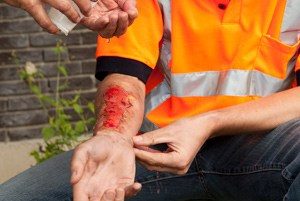National Burn Awareness Day
Burns and scalds injuries in the workplace
CE Safety has analysed Labour Force Survey and found that, between 2015 and 2018, 23,000 workers reported suffering from non-fatal burns or scalds.
 This statistics means that an average of 75 workers out of every 100,000 have suffered from a burn or scald at work. Between 2013 and 2018, five people were reported to have suffered fatal burn injuries, and 1,745 reported non-fatal burn injuries, according to RIDDOR.
This statistics means that an average of 75 workers out of every 100,000 have suffered from a burn or scald at work. Between 2013 and 2018, five people were reported to have suffered fatal burn injuries, and 1,745 reported non-fatal burn injuries, according to RIDDOR.
Employers should be aware of how to act, should they ever be faced with an employee that has a burn injury.
Here are six steps employers can follow when dealing with an employee with burn injuries:
- Quickly stop the burning by removing the person from the area, dousing flames with water or smothering flames with a blanket;
- Remove any clothing or jewellery near the burnt area but nothing which is stuck to burnt skin and could cause further damage;
- Cool the burn with cool water for 20 minutes as soon as possible. Never use ice, iced water or greasy substances, like butter;
- Keep the person warm using blankets or clothing but never place them on the injured area. Warmth will prevent hypothermia, where a person’s body temperature drops below 35C (95F). Hypothermia is a risk when cooling a large burnt area;
- Place a layer of cling film over the burn, rather than wrapping around a limb. A clean plastic bag can be used for hand burns;
- Sit upright if the face is burnt. Avoid lying down as this could increase swelling.
The most prevalent types of injury which are self-reported include strain and sprain, superficial, lacerations and open wounds, fracture and broken bones, burns and scalds, and dislocation of joints.
According to the World Health Organization, the most common types of burn injuries in the workplace occur as a result of accidental misuse or mishandling of thermal, chemical or electrical sources or because of fire. However, the HSE states that many serious burn accidents at work could have been avoided if precautions were taken. Employers can be fined heavily if these injuries result from unsafe work practices, including employees not having the correct protective clothing or equipment.
Gary Ellis, Health and Safety Trainer at CE Safety, says: “The British Burns Association, confirmed that while the most common place of injury is the home for children and the elderly, for adults, it is the workplace. The data we analysed show that the number of self-reported burn injuries is worryingly high.”
“If you or someone else has been burnt, make sure that you immediately visit A&E if the burns are bigger than the victim’s hand, if the burns cause white or charred skin, you or the victim are burnt on the face, hands, arms, feet, legs or genitals that cause blisters, or the burns are chemical or electrical.
“All burns and any other injuries in the workplace need to be taken seriously. Ensure you are aware of where your first aid kit is or who is the person, in your team, who has undergone first aid training to ask them any questions you might have.”
Click here to access the full report.
Burns and scalds injuries in the workplace
CE Safety has analysed Labour Force Survey and found that, between 2015 and 2018, 23,000 workers reported suffering from non-fatal burns or scalds.
Samah Ahmed
SHP - Health and Safety News, Legislation, PPE, CPD and Resources Related Topics
Company fined £360k after trapped worker loses life
Company fined after worker crushed to death
Legal insight: Common errors in fire safety

